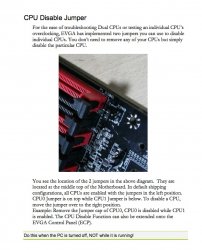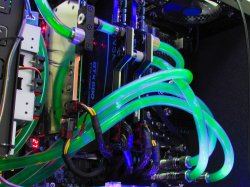I get nothing except the other site you posted this on. How about a link?
You know I can't find the site now. The only site that pops up is some asian site, but when I try to Google Translate it only partially converts the language. The static images (jpeg buttons) won't translate. So I don't know which button to press and when I do, I think it's asking for your sign in info and since I'm not a member of that forum site and can't read Chinese, oh well... DARN YOU - GOOGLE !!!
Assuming the same linearity Otoy says adheres to Octane when GTX cards are used, is universal, then if one EVGA GTS 580 performs the rendering test in 6:24 minutes, and one EVGA 580 + one C2070 performs the test in 4:54 min and one EVGA 580 + another EVGA 580 + one C2070 performs the test in 3:11 min, then the addition of the C2070 shaved (6:24 - 4:54 = ) 90 seconds off that longest time and the addition of another 580 shaved (4:54 - 3:11) 103 seconds off that 2nd fastest time.
Two or more CUDA cards (whether GTX and/or Tesla) should work in tandem if the CUDA code is written properly.
Therefore, a second EVGA 580's should perform the render test in about 4:41 min [6 * 60 sec/min + 24 sec = 384 sec using one GTX 580; a second GTX 580 should cut the render time by another 103 sec or 384 - 103 = 281 sec [281 / 60 = 4.68333333333333; 0.68 * 60 = 40.8; 4 + .408 =~ 4:41 min using 2 GTX 580s]].
Using a third GTX 580 should result in a time of under 3 minutes [384 - (103x2 or 206) = 178; 178 / 60 = 2.96666666666667; 0.97 * 60 = 58.2; 2 + .582 =~ 2:58 min using 3 GTX 580s].
If that 6:24 test result is accurate and your future test results using 2 or 3 GTX 580s differ significantly, then the linearity that Otoy says adheres to Octane when using GTX cards, may not be universal. That CUDA lacks or fails to maintain linearity universally is a important finding and adds to our body of knowledge about GPU-assisted compute performance.
Now to address Tutor (and anyone else reading this), as I was able to (before) disconnect the C2070 to test the other cards out, I am not able to do that now; as it won't get past the Apple icon when I boot it. This is mainly because of the custom DSDT file that Rampage set up for me. Even though I have the other DSDT files that would enable me to make that happen (as I keep everything anyway), I'm not going to mess with that. So with that said, you're just going to have to be good with the through testing that I've done (with Mac OS X) as well as what the other russian guy performed in his testing (in Windows 7), as they were almost identical in their rendering times.
On the surface of your calculations, I hear you on what you estimated, but from working with Rampage on the C2070 (as he has servers that are dedicated using stacks of these very same cards using CS6 AE & PR when it comes to video rendering) as well as our personal tests using the 580 and 680, I'm going to stick with his knowledge base on that one for now, when it comes to CUDA and LIVE Mercury Playback.
I do have to say something about Rampage. I appreciate what he does is he'll block off the time and we'll Skype each other
live to bang out the work until we're done as he knows my talents with understanding the programming end of things are really limited to just the
building part of PCs, as his talent is the
programming part of PCs. So I'm grateful for that
LIVE help when we're able to do it. We both really got the satisfaction of working together and I feel we were (and still are) a great team in making that happen. So for that I'm happy to know that FINALLY someone was able to give all the extended help that was needed (and then some) to make that happen. Again, I'm VERY GRATEFUL to him. I could have not done that without his direct help
He really is amazing though for a young guy that not only has his own site that shows you (with step by step instructions and pics included) how to create your own DSDT and like kind type files, he'll actually go the extra mile and give you premium technical support (for a small donation) to get you up and running in no time flat. Had I met him 18 months ago I'd would have been up and running MUCH FASTER instead of the fumbling and stumbling (and arguing with a few people to get their assistance). I'm glad he offers both the opportunity to learn it yourself AND doing it
for you (unlike someone else that we know that I bantered back and forth with on InsanelyMac that wasn't very helpful) Tutor knows the guy I'm talking about.
Which brings me back to my original point with that guy (on InsanelyMac),
not everyone can have the same talents. Like Tutor for example, He's great when it comes to his Underclocking, some programming and whatever calculative skills he likes dropping on us (like what he just did on the above reply - LOL !!!). Rampage is great when it comes to getting your install in order with his customized DSDT, and other important key files, as well as streamlining your Extra folder to get you the best possible running system you can have. Me on the other hand, well
I'd like to think that I'm a good, clean and tight professional PC builder as well as a good networker of sorts with others on various forums to get people connected with each other so their needs can be met. At least that's the feedback that I've been receiving from others that have told me this directly.
Again, not everyone can do
EVERYTHING, and quite honestly
I'm okay with that (as I have been for quite some time). As a result I've had quite a few guys that have the same (or similar) SR-2 build that have needed some help to get their system either up and running, or tweaked to max out their performance; where they too
don't have the programming wherewithal or understanding that a guy like RampageDev and Tutor does. I'm just glad that I get to be used as a "vessel" (so to speak) so they don't have to go through the same MONTHS of headaches like I did to get their system running at their best.
Now, the first thing I do when someone reaches out to me for help is tell them to go to RampageDev -
FIRST over anyone else (as well as voluntarily tossing him some duckets to help him out; as I think that's a very fair thing to do and he's worth EVERY PENNY).
Then I have them go to other sites, like this one (which I call
"Tutor's Way"), and posts like his to go about maxing out their performance by way of either Underclocking or Overclocking.
Personally, I still like Underclocking better, because it confuses the heck out of people as it does the opposite of what we've been taught and actually
PERFORMS FAR BETTER, (and I know that Tutor gets a kick out of that, being that he's the guy that discovered it). But since I have 10.8.3 up and running now and not 10.6.8 anymore, as well as most of my performance is being used by the GPUs anyway, I'm going to stick with what I have for time being. I'm sure (if that time comes around) where UC'ing is achievable by having 10.8.X or above in the future, Tutor will be the man who'll bring that to light so we can ALL benefit from it.
I'm still surprized that the EVGA SR-2 Mobo setup has been the KING of Hackintosh performance for a OC'able Dual CPU setup for 3 years+ and still (I believe) has another 3 years to go. Tutor, BrainDeadMac, Peconi, mainHybrid, mike d, myself and a few others that I know of have benefitted from this amazing SR-2 Mobo and still are. There is so much expandability to this Mobo
it's just SICK!!! I'm just glad that I got to be a part of something this great and was also even that much more grateful for being the reason why others wanted to build the same system. It's an awesome feeling !!! So thanks for compliments and hope to see more builds like this one...

Lastly, I know I went off on some tangents here and there, and I've confused anyone or given TMI, then please forgive me
Later...





